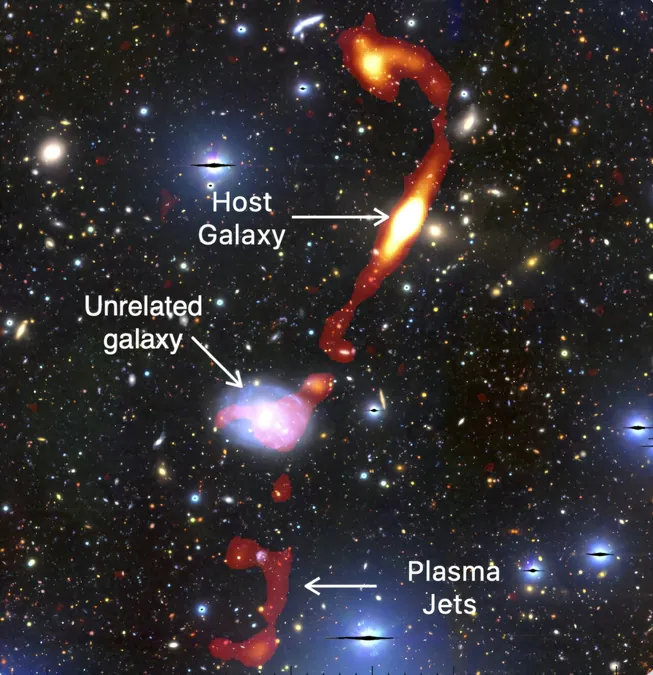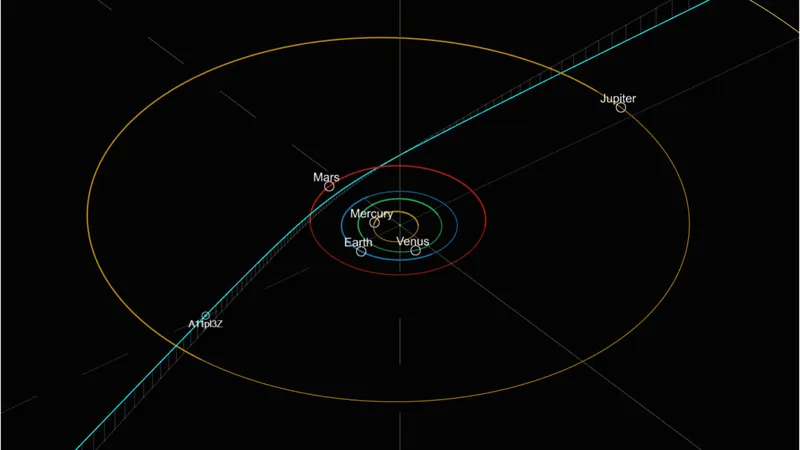
Astronomers Uncover a 'Troublesome' Giant Radio Galaxy—32 Times Bigger Than the Milky Way!
2025-01-20
Author: Liam
Discovery of Inkathazo
In a groundbreaking revelation, astronomers have unveiled a colossal new radio galaxy, dubbed Inkathazo, that measures a staggering 3.3 million light-years across—32 times the size of our very own Milky Way. This extraordinary cosmic structure was detected by the cutting-edge MeerKAT telescope in South Africa and has garnered its nickname, which translates to 'trouble' in the Xhosa and Zulu languages, due to its perplexing nature.
Significance of the Discovery
The discovery, published in the Monthly Notices of the Royal Astronomical Society, presents a thrilling opportunity to gain insights into the enigmatic origin and evolution of one of the universe's largest structures. Giant radio galaxies (GRGs) like Inkathazo are monstrous phenomena that propel jets of hot plasma across vast stretches of intergalactic space. These jets, which emit radio waves, are powered by supermassive black holes situated at their galactic cores.
Rise in GRG Discoveries
Until recently, GRGs were believed to be relatively uncommon. However, with the advent of advanced radio telescopes such as MeerKAT, this belief has been thoroughly challenged. 'The number of GRG discoveries has skyrocketed over the last five years, thanks to the power of new telescopes like MeerKAT,' remarked Kathleen Charlton, a Master's student at the University of Cape Town and the lead author of the study. 'The rapid development of research on GRGs is captivating!'
Unique Characteristics of Inkathazo
Charlton explained that Inkathazo stands out among GRGs due to its unconventional plasma jets, which are not only massive but also exhibit unusual shapes—one of the jets appears bent rather than extending straight across. Moreover, what perplexes researchers is that Inkathazo is located at the center of a galaxy cluster, a setting that typically makes it challenging for plasma jets to achieve such extreme dimensions.
Implications of the Findings
'This exciting and unexpected find raises new questions about how environmental factors influence the formation and growth of these immense galaxies,' said Dr. Kshitij Thorat, a co-author of the study from the University of Pretoria.
Research Methodology
To unravel the mysteries surrounding Inkathazo, the research team utilized MeerKAT's state-of-the-art capabilities to create high-resolution spectral age maps. These maps, which track the age of plasma throughout different sections of the galaxy, offer valuable clues about the underlying physical processes. Their results unveiled fascinating complexities in Inkathazo's jets, suggesting that some electrons were receiving unexpected energy boosts—likely caused by interactions with hot gases in the intergalactic medium of the cluster.
Challenging Existing Models
'This discovery allows us to dive deep into GRG physics with unparalleled detail,' Dr. Thorat noted, highlighting that their findings challenge existing physical models and imply that our understanding of the intricate plasma dynamics within such extreme galaxies is still in its infancy.
Focus on Southern Galaxies
Interestingly, the search for GRGs has predominantly focused on northern latitudes using European telescopes. In contrast, the southern sky remains largely uncharted territory for these titanic objects. Inkathazo is not alone; it is the third GRG found in a relatively small sky region known as COSMOS, which is about the size of five full moons. Prior observations in 2021 by the international 'MIGHTEE' collaboration also identified two additional GRGs in the same patch of sky with the MeerKAT telescope.
Potential for More Discoveries
The discovery of three GRGs in a single observational sweep suggests an untold number of similar cosmic giants could be hiding in the southern sky. 'MeerKAT's incredible power and optimal location position it beautifully to uncover and study these elusive galaxies,' stated Dr. Jacinta Delhaize, a researcher at the University of Cape Town and leader of the 2021 study.
Future Prospects
As MeerKAT serves as a precursor to the anticipated Square Kilometer Array (SKA), which is set to launch by the end of this decade, its unprecedented sensitivity and resolution promises an exciting future for astronomical discoveries like the enigmatic Inkathazo. Astronomers and space enthusiasts alike are standing by in anticipation—who knows what else may be lurking in the depths of the cosmos?









 Brasil (PT)
Brasil (PT)
 Canada (EN)
Canada (EN)
 Chile (ES)
Chile (ES)
 Česko (CS)
Česko (CS)
 대한민국 (KO)
대한민국 (KO)
 España (ES)
España (ES)
 France (FR)
France (FR)
 Hong Kong (EN)
Hong Kong (EN)
 Italia (IT)
Italia (IT)
 日本 (JA)
日本 (JA)
 Magyarország (HU)
Magyarország (HU)
 Norge (NO)
Norge (NO)
 Polska (PL)
Polska (PL)
 Schweiz (DE)
Schweiz (DE)
 Singapore (EN)
Singapore (EN)
 Sverige (SV)
Sverige (SV)
 Suomi (FI)
Suomi (FI)
 Türkiye (TR)
Türkiye (TR)
 الإمارات العربية المتحدة (AR)
الإمارات العربية المتحدة (AR)